|
|
|
Sort Order |
|
|
|
Items / Page
|
|
|
|
|
|
|
| Srl | Item |
| 1 |
ID:
141593
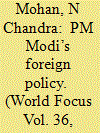

|
|
|
|
|
| Summary/Abstract |
Prime Minister Narendra Modi’s foreign policy has been credited with more achievements than the NDA government’s policies to turnaround the Indian economy. What is so distinctive about his foreign policy? Has he blazed a different trail from his predecessor, Dr Manmohan Singh? Economic diplomacy is a forte they have in common. Both enjoy their foreign travels. During his first year in office, PM Modi visited 17 countries and spent 53 days abroad. This is not very different from Dr Singh’s frequent flyer miles during UPA-11 when he visited 12 countries and spent 47 days outside
|
|
|
|
|
|
|
|
|
|
|
|
|
|
|
|
| 2 |
ID:
133568
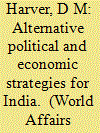

|
|
|
|
|
| Publication |
2014.
|
| Summary/Abstract |
D M Harver analyses the changing patterns of political ideology and economic thinking in India post-1985 and looks at the changing economic philosophy embraced by successive central and state governments. He also traces the main causes of the re-emergence of religiosity as a political factor.
|
|
|
|
|
|
|
|
|
|
|
|
|
|
|
|
| 3 |
ID:
109713
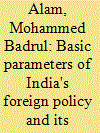

|
|
|
| 4 |
ID:
108895
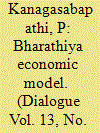

|
|
|
| 5 |
ID:
131122
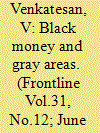

|
|
|
|
|
| Publication |
2014.
|
| Summary/Abstract |
The decision to constitute a special investigation team to investigate cases of black money stashed away in foreign banks will prove to be an acid test for the Narendra Modi government as the fight against the black economy, calls for the strong political will.
|
|
|
|
|
|
|
|
|
|
|
|
|
|
|
|
| 6 |
ID:
125310
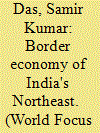

|
|
|
|
|
| Publication |
2013.
|
| Summary/Abstract |
Border trade perhaps is the answer - only if we realize that there is a larger moral economy of border trade the gains of which far outweigh its meagre economic returns. Doesn't the moral economy of border trade force us to revisit both the dominant discourses of national security and functional integration and see how they mutate and transform under present conditions?
|
|
|
|
|
|
|
|
|
|
|
|
|
|
|
|
| 7 |
ID:
028666
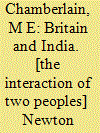

|
|
|
|
|
| Publication |
Newton Abbot, David and Charles, 1974.
|
| Description |
272p. hbk
|
| Series |
Library of Politics and Society
|
| Standard Number |
0715364065
|
|
|
|
|
|
|
|
|
|
|
|
Copies: C:1/I:0,R:0,Q:0
Circulation
| Accession# | Call# | Current Location | Status | Policy | Location |
| 014922 | 954/CHA 014922 | Main | On Shelf | General | |
|
|
|
|
| 8 |
ID:
130601
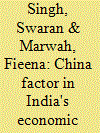

|
|
|
|
|
| Publication |
2014.
|
| Summary/Abstract |
The technology driven time-and-space shrink in recent decade have turned open oceans from barriers to bridges. This has opener new frontiers for trade and transportation, for resource exploitation as also for adventurous scientific explorations into the history 0 human evolution as also into our future. This recent paradigm shift is distinct from the discovery of steam ship leading to naval fleets ancient colonialism in the 19"'century which was focused not only on European powers' control and exploits but also on continental humarjand material resources of their colonies across the world. The recent maritime discourses have instead opened up enormous new avenue entities even to achieve their basic national development and security objectives.
|
|
|
|
|
|
|
|
|
|
|
|
|
|
|
|
| 9 |
ID:
118875


|
|
|
| 10 |
ID:
134046
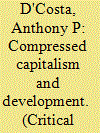

|
|
|
|
|
| Publication |
2014.
|
| Summary/Abstract |
The global capitalist system is at a particular historical juncture with a dilution of the capitalist core away from Western (and Japanese) centers of accumulation to China and India, among other countries. What is the nature of capitalism in these countries? Are China and India going along the same development trajectories that advanced capitalist countries followed earlier? Is their accumulation model the same as that of the OECD economies or is accumulation different under late capitalism? The author argues that capitalism in India and China is "compressed," meaning that the phases of capitalism do not follow one another in sequential order. Instead, some phases, such as primitive accumulation, may be delayed or be experienced at the same time as advanced accumulation under the corporate sector, thereby producing a mode of development that does not generate widespread employment. The author contends that capitalism in India and China is compressed and he demonstrates empirically that primitive accumulation, petty commodity producing sectors, and mature capitalism in late-industrializing countries reinforce each other, creating precarious forms of employment in the process.
|
|
|
|
|
|
|
|
|
|
|
|
|
|
|
|
| 11 |
ID:
131039
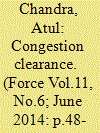

|
|
|
|
|
| Publication |
2014.
|
| Summary/Abstract |
India's growing civil aviation sector now has an increasing number of scheduled, non-scheduled airlines, flying institutes and private-use aircraft that will require a larger number of airports and airfields to enable air connectivity across all corners of the country.
The Airports Authority of India (AAI) had already begun work on 50 low-cost airports, located in remote and interior areas of the country. In addition to this greenfield airports at Navi Mumbai, Goa, Kannur and Kushinagar, AAI has identified six airports for private management under the Public Private Partnership (PPP) route following the successful implementation of PPP models in Delhi, Mumbai, Bengaluru, Hyderabad and Cochin.
All these measure will not only lead to more airports but also increased utilisation of existing airports, thus helping to increase air traffic but at the same time putting additional pressure on airspace management. In another recent move, the government allowed flexi use of airspace by civil and military users on a sharing basis, which will enable the available airspace to be used in a more optimised and effective manner.
|
|
|
|
|
|
|
|
|
|
|
|
|
|
|
|
| 12 |
ID:
152458
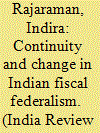

|
|
|
|
|
| Summary/Abstract |
This article focuses on whether the discontinuity in the structure of the Indian economy, which started with the economic reforms of 1991, triggered changes in federal fiscal arrangements. This examination is embedded in a larger overview of the basic fiscal structure, characterized by annual flows from the national government (the “Center”) to subnational states that have both statutory (guaranteed and formulaic) and non-statutory (discretionary) components. An unforeseen consequence of trade liberalization was the loss of trade tax revenue, which drove down tax collections at the Center both as a percent of GDP, and relative to states. Four major policy changes initiated after 1991 are attributable to post-reform concerns with efficiency in the fiscal structure. The final shift of indirect taxation to a fully value added configuration, with comprehensive coverage of goods and services, is scheduled for introduction by September 16, 2017.
|
|
|
|
|
|
|
|
|
|
|
|
|
|
|
|
| 13 |
ID:
173611
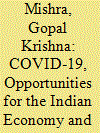

|
|
|
|
|
| Summary/Abstract |
In comes March 2020 and the whole world got sucked into a new way of life. The changes to life that we are living today after March 2020, reminds me of our childhood days, when we, as students, were using ink pens. Poor ink, had no control over itself; inside ink bottles till it is opened, spilled on the floor due to inappropriate handling by us as a kid, then it got sucked into the dropper to be dropped inside the pen for writing and ultimately to be dried in the sheet of writing paper and the ink felt liberated.
|
|
|
|
|
|
|
|
|
|
|
|
|
|
|
|
| 14 |
ID:
120733
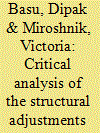

|
|
|
|
|
| Publication |
2013.
|
| Summary/Abstract |
The analysis of the Indian economy, since the structural reform to dismantle the mixed economic planning and to establish market economy, is presented here with clear analysis regarding growth of the macro economy, the real economy and the social impacts in terms of employment. The picture was quite dismal until the short-term portfolio investments from abroad were introduced a few years ago. The recent upsurge of growth is thus the result of these short-term foreign investments.
|
|
|
|
|
|
|
|
|
|
|
|
|
|
|
|
| 15 |
ID:
089445
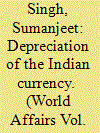

|
|
|
| 16 |
ID:
138361
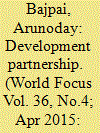

|
|
|
|
|
| Summary/Abstract |
India needs to address various challenges to make her development partnership more effective. If India's development partnership has to work as 'soft power' instrument of India's economic diplomacy, it has to be motivated by the spirit of sharing, equal partnership, mutual benefit, and India's entitled national interest.
|
|
|
|
|
|
|
|
|
|
|
|
|
|
|
|
| 17 |
ID:
154049
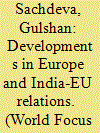

|
|
|
|
|
| Summary/Abstract |
In the last few years, Europe is facing many challenges. These include difficulties in managing a single currency mechanism, influx of refugees, crisis in Ukraine, terrorist attacks, rise of populism and British exit from the European Union (EU). Despite these difficulties, the EU is still a major economy with huge capacities to influence issues concerning global governance. As a major trade and investment partner of India, developments in Europe have significant implications for the Indian economy and India-EU ties. After a few years of sluggishness, India-EU strategic partnership is again gaining momentum with an agreed Agenda for Action 2020. As negotiations on bilateral trade and investment agreement may take time, both India and the EU are focusing on other areas where increased consultations can lead to concrete outcomes. The areas include climate change, energy, environment, counter-terrorism, maritime security, science and technology, development cooperation, migration and mobility, civil society linkages and dialogues on Asia and Africa.
|
|
|
|
|
|
|
|
|
|
|
|
|
|
|
|
| 18 |
ID:
119395
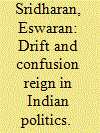

|
|
|
|
|
| Publication |
2013.
|
| Summary/Abstract |
[T]he prospect of India without a stable governing coalition-whether established by the Congress Party, by the BJP, or by regional parties supported by either the Congress or the BJP-is not beyond the realm of possibility.
|
|
|
|
|
|
|
|
|
|
|
|
|
|
|
|
| 19 |
ID:
128213
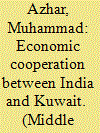

|
|
|
|
|
| Publication |
2014.
|
| Summary/Abstract |
Over two decades of liberalization and reforms have resulted in India becoming the second fastest growing economy in the world. Having the second largest population in the world, it is also a vast repository of skilled manpower. However, the significant growth in Indian economy has increased the demand for energy substantially. Consequently, India has to import 80 per cent of its petroleum crude requirement. In contrast to India, Kuwait is very small in size and population. But it is very rich in hydrocarbon resources. The economic cooperation between India and Kuwait is deep rooted. It consists of bilateral trade inclusive of energy imports, Indian expatriate workers in Kuwait and the inflow of remittances, Kuwaiti aid and prospective Kuwaiti investments. The article is a detailed study of all these aspects of economic cooperation between the two countries.
|
|
|
|
|
|
|
|
|
|
|
|
|
|
|
|
| 20 |
ID:
116152
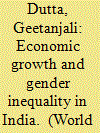

|
|
|
|
|
|
|
|